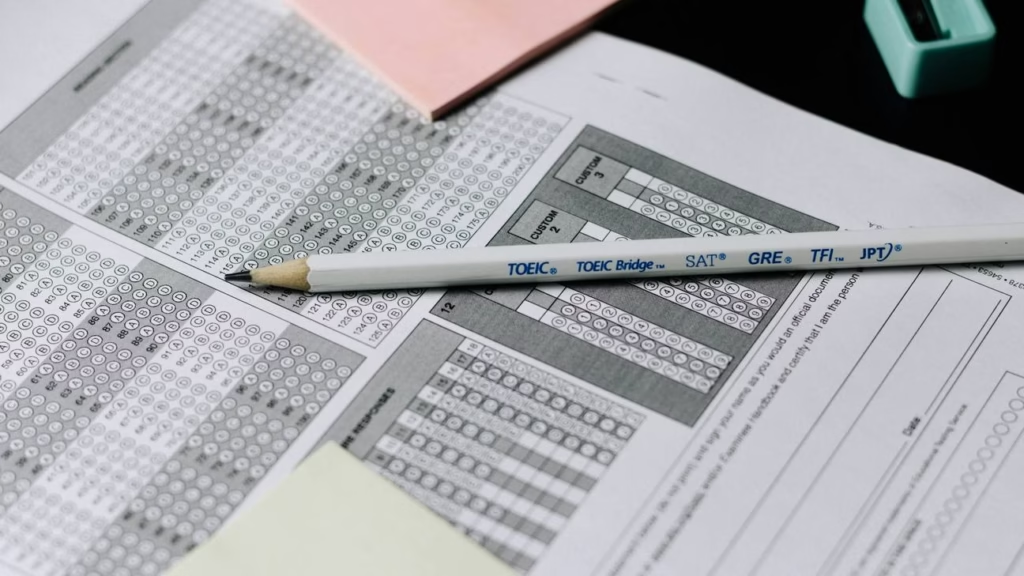Boost your AP Bio score with proven study tips, practice strategies, and time management hacks to master the exam with confidence.
Table of Contents
Introduction
The AP Biology exam is tough. It covers so much. You learn about tiny cells and big ecosystems. The test focuses on data. It asks you to think, not just remember. Many students use flashcards to study. This is a mistake. They struggle on test day.
Do not just cram. You need a smart plan. Focus on the big topics. Practice with real questions. Use your time well. Looking for good study tips? This guide will help you prepare. Feel confident on test day.
We will share simple steps. Learn what to study first. Get better at writing answers. You will have a clear plan. This plan will boost your score. It will also cut your stress. See where you stand with the AP Bio Score Calculator.
1. Know the AP Bio Exam
Start your study plan by learning the test’s layout. This helps you study the right way. You will feel ready and confident on exam day. Wondering how to prepare for AP Bio? Start here.
🧩 Multiple-Choice Questions
- You will have 90 minutes for 60 questions.
- They test your facts and how you use ideas.
- Many ask you to look at graphs or data first.
- Quick tip: Skip hard questions. Come back to them later.
✍️ Free-Response Questions
- You will have 90 minutes for 6 questions.
- 2 are long. They need detailed answers.
- 4 are short. They focus on one skill, like making a graph.
- Quick tip: Use claim, evidence, reasoning to write clear answers.
📊 What to Study First
Some topics are on the test more than others. Focus on the big ones.
The biggest topics are:
- Natural Selection
- Gene Expression
- Cellular Energetics
Other topics like Cells and Ecology are also big. But start with the heaviest ones.
📥 Your Next Step
Get the official guide from the College Board. It lists everything you need to know. Download it for free. Get it here.
2. Master FRQ Skills Early
Want a higher AP Bio score? Master the Free Response Questions. These questions test your critical thinking. You must use biology ideas and explain your reasoning. Start practicing them soon. You will feel much more confident on test day.
Structure Answers with C‑E‑R
Use this simple method for strong answers.
- Claim – State your answer in one clear sentence.
- Evidence – Give facts or data that back up your claim.
- Reasoning – Explain how your evidence proves your claim.
This plan keeps your writing clear. It helps you earn points for your knowledge and your explanation.
Get Good with Data
Many questions have graphs or charts. You need to understand them.
- Practice reading graphs and tables.
- Explain what the data shows in your own words.
- Always link the data back to the science topic.
🔍 Sample FRQ Breakdown
Question: A population of beetles shows variation in shell color. Over several generations, darker beetles become more common. Explain this trend.
- Claim: Darker beetles increased in frequency due to natural selection.
- Evidence: Predators were less likely to spot darker beetles against the soil background, so they survived and reproduced more.
- Reasoning: Because survival and reproduction are higher in darker beetles, the allele for dark coloration became more common in the population over time.
The test wants you to explain data, not just remember facts. You earn points for your analysis.
See it in action:
A question asks why a fish dies in fresh water. Your answer could be:
- Claim: The fish died because its cells took in too much water.
- Evidence: Fresh water has more water and less salt than the fish’s cells.
- Reasoning: Water moves to areas with more salt. So, water rushed into the fish’s cells, making them swell and burst.
Your Key Takeaway
Start doing FRQs now. Use the C-E-R method. Practice with data. You will be ready for anything on the exam.
3. Use a calculator for chi-square tests and data analysis
Calculators are allowed on the AP Biology exam, and they’re especially useful for quick arithmetic, square operations, and checking ratios in data-based questions. A simple scientific or graphing calculator helps you avoid small mistakes, move faster through computations, and stay focused on your biological reasoning rather than manual math. Always verify your school’s test-day policy, but plan to practice with the same calculator you’ll use on the exam so key functions feel natural.
When calculators are most useful
- Chi-square tests: Rapidly compute ((O-E)^2), divide by (E), and sum terms for (\chi^2). [ \chi^2=\sum \frac{(O-E)^2}{E} ]
- Rates and proportions: Calculate growth rates, percent change, and normalized ratios from tables or graphs. [ \text{Rate}=\frac{\Delta y}{\Delta t},\quad %\text{ change}=\frac{\text{new}-\text{original}}{\text{original}}\times 100 ]
- Log/exp operations: Handle exponential growth/decay and pH calculations without manual approximations. [ \text{pH}=-\log[\text{H}^+] ]
Step-by-step chi-square example (mini-table)
Assume you cross pea plants for flower color with a predicted 3:1 ratio (purple:white). You observe 85 purple and 35 white (total 120). Is the deviation significant at (\alpha=0.05)?
| Step | Action | Calculation | Result | Why it matters |
|---|---|---|---|---|
| 1 | Compute expected counts | Purple: (120\times 0.75), White: (120\times 0.25) | (E_P=90,\ E_W=30) | Aligns data with predicted ratio |
| 2 | Find deviations | (O-E) for each phenotype | (P:85-90=-5,\ W:35-30=5) | Direction and size of differences |
| 3 | Square deviations | ((O-E)^2) | (P:25,\ W:25) | Removes sign, emphasizes magnitude |
| 4 | Divide by expected | (\frac{(O-E)^2}{E}) | (P:\frac{25}{90}\approx 0.278,\ W:\frac{25}{30}\approx 0.833) | Standardizes deviations |
| 5 | Sum for (\chi^2) | Add category values | (\chi^2\approx 0.278+0.833=1.111) | Test statistic |
| 6 | Degrees of freedom | (df=n-1) with (n=2) categories | (df=1) | Selects critical value |
| 7 | Compare to critical | At (df=1,\ \chi^2_{0.05}=3.84) | (1.111<3.84) | Not significant; fits 3:1 ratio |
Interpretation
- Conclusion: The observed counts are not significantly different from the expected 3:1 ratio; deviations are likely due to chance. [ \text{Since } \chi^2(1.111)<\chi^2_{0.05}(3.84),\ \text{fail to reject }H_0 ]
Quick tips for calculator efficiency
- Use memory keys: Store totals and expected values to avoid retyping.
- Sequence your operations: Compute all (O-E) first, then squares, then divisions, then sum.
- Round sensibly: Keep at least 3–4 decimal places until the final (\chi^2) sum; round conclusions, not intermediate steps.
Keyword integration for SEO
If you’re building an AP Bio study guide for data analysis, include a dedicated subsection on calculator workflows for chi-square, rates, and pH. Target phrases like “AP Biology study tips,” “how to prepare for AP Bio exam,” and “AP Bio study guide for data analysis” naturally within explanations and captions to help readers—and search engines—recognize the practical value of your methods.
4. Build a Daily Study Schedule
One of the most effective AP Biology study tips is consistency. Instead of cramming the night before, aim for 30–45 minutes of focused study each day. Short, regular sessions help you retain information longer and reduce stress.
Alternate Between Content Review and Practice
To maximize efficiency:
- Day 1: Review a high-weight unit (e.g., Natural Selection, Gene Expression).
- Day 2: Apply that knowledge with practice MCQs or FRQs.
- Day 3: Return to content review, focusing on weak spots.
- Day 4: Practice again under timed conditions.
This alternating rhythm keeps your brain active, strengthens recall, and builds exam stamina.
📅 Sample 2-Week AP Bio Study Schedule
Here’s a flexible 14-day plan you can adapt to your own pace. Each session is designed for 30–45 minutes.
| Day | Focus | Activity |
|---|---|---|
| Day 1 | Natural Selection | Review notes + diagrams |
| Day 2 | Natural Selection | Practice 10 MCQs |
| Day 3 | Gene Expression | Review transcription/translation |
| Day 4 | Gene Expression | Practice 1 FRQ |
| Day 5 | Cellular Energetics | Review photosynthesis & respiration |
| Day 6 | Cellular Energetics | Practice data-based MCQs |
| Day 7 | Review Week 1 | Quick quiz + flashcards |
| Day 8 | Cell Communication | Review signaling pathways |
| Day 9 | Cell Communication | Practice 1 FRQ |
| Day 10 | Ecology | Review population dynamics |
| Day 11 | Ecology | Practice data interpretation |
| Day 12 | Genetics | Review Mendelian & non-Mendelian |
| Day 13 | Genetics | Practice chi-square problem |
| Day 14 | Review Week 2 | Take 25 MCQs timed |
Key Takeaway
A daily study schedule keeps you on track, prevents burnout, and ensures you cover both content review and practice questions. By following a structured plan like this, you’ll steadily build confidence and exam readiness without the stress of last-minute cramming.
5. 🎨 Use Visual Study Aids
Turn complex topics into pictures. Diagrams and maps help you see how ideas connect. This makes facts easier to remember on test day.
Draw Key Processes
Some topics are on the test a lot. Draw these:
- Photosynthesis
- Cellular Respiration
- DNA Replication
Tip: Draw them yourself. Don’t just copy. Drawing helps your brain learn.
Try Digital Tools
Use apps to study anywhere.
- Quizlet or Anki for flashcards.
- Lucidchart to make concept maps.
- Notion to keep all your notes in one spot.
These tools help you organize and review.
Add Color
Colors help your brain sort and recall information.
- Use green for energy topics.
- Use blue for things like DNA.
- Use red for important enzymes.
For example, color all enzymes red in your DNA drawing. This makes the steps stand out.
Your Key Takeaway
Pictures make tough topics simple. Use drawings, apps, and color in your notes. You will understand more and remember it all on the exam.
6. ⏱️ Manage Your MCQ Time
The MCQ section is a race against the clock. You have 90 minutes for 60 questions. You need to be both fast and right. Good timing helps you get all the points you can.
| Time Elapsed | Target Question Number | Time Remaining |
|---|---|---|
| 15 minutes | ~15 | 75 minutes |
| 30 minutes | ~30 | 60 minutes |
| 45 minutes | ~45 | 45 minutes |
| 60 minutes | ~60 | 30 minutes |
| 75 minutes | Review flagged questions | 15 minutes |
| 90 minutes | Finish section | 0 minutes |
Skip the Hard Ones at First
If a question is tricky, don’t stop. Just mark it and move on. Do all the easy questions first. Then go back to the ones you skipped. This helps you stay on track and get more points.
Spend About 1 Minute Per Question
Try to spend one minute on each question. Some will be faster. This gives you extra time for the hard ones. Watch the clock, but do not hurry too much. Being correct is what matters.
Your Key Takeaway
Use a smart plan, not just speed. Spend one minute per question and come back to the tough ones. This is the best way to do well on the MCQs.
7. ✍️ Plan Your FRQ Approach
The FRQs are half your exam score. You need a solid plan. These questions test how well you explain your ideas in writing.
Divide Your Time Well
You have 90 minutes for 6 questions. Use your time wisely.
- Spend about 20 minutes on each long question.
- Spend about 10 minutes on each short question.
- Watch the clock. Do not let one question take all your time.
🚫 Top 3 FRQ Mistakes to Avoid
- Skipping parts of the question: Always answer every subpart (a, b, c). Partial answers = lost points.
- Writing essays instead of direct responses: The exam rewards concise, evidence-based answers—not fluff.
- Forgetting to connect evidence to reasoning: Don’t just state facts—explain how they support your claim.
Plan Before You Write
Do not start writing right away. Your answers can get messy.
- First, read the whole question. Find all its parts.
- Then, make a quick outline. Note your main claim, evidence, and reason.
- Finally, write. Keep your answer short and clear. Follow your plan.
This makes sure you answer every part of the question.
Your Key Takeaway
A good plan saves you. Manage your time, outline your answers, and write clearly. Practice this way to score high and feel ready.
8. 🧠 Study Smarter, Not Harder
To really learn AP Bio, use active recall and spaced repetition. Do not just read your notes. Test yourself. Pull the facts from your memory. This makes your brain stronger and faster for the test.
Use Flashcards, Not Just Reading
Reading your notes feels easy. But it tricks you. You think you know it, but you do not. Flashcards make you work. You have to remember the answer before you look.
- Example: Make a card that asks, “Where does the Krebs cycle happen? What does it make?”
This hard work helps you remember for a long time.
Let Apps Plan Your Review
Some apps know the best time to study. They show you cards right before you forget.
- Anki does this for you. It is great for terms and processes.
- Quizlet is also great for quick study on your phone.
Use them for tough topics like photosynthesis or DNA.
Test Yourself Often
After you study a unit, close your book. Ask yourself questions.
- Use real practice questions from the College Board.
- Try both multiple-choice and free-response questions.
- Find your weak spots. Then make new flashcards for them.
Your Key Takeaway
Stop passive reading. Start active recall. Use apps and self-tests to build a strong memory. You will walk into your exam feeling sure of yourself.
9. 🎯 Practice Like It’s Test Day
Knowing the facts is key. But it is not enough. You must practice under real exam conditions. Feel the pressure of the clock before the real test.
Do a Full Practice Test
Take one complete test before exam day.
- Do 90 minutes of multiple-choice questions.
- Then do 90 minutes of free-response questions.
- Use a real practice exam from the College Board.
- Do not pause. Do not take breaks. Treat it like the real thing.
This builds your speed and mental strength.
Make It Feel Real
Set up your practice to match the test.
- Find a quiet spot. Silence your phone.
- Use a timer. Stick to it strictly.
- Sit at a desk. This helps you focus.
- Use only the tools allowed on test day.
This makes the real exam feel familiar, not scary.
Build Your Focus Muscle
The test is a 3-hour marathon. You need to train for it.
- Practice holding your focus for a long time.
- Learn to push through mental tiredness.
- Stay calm under pressure.
You would not run a race without training. Do not take the test without a trial run.
Your Key Takeaway
Do a full, timed practice test. Make it feel real. Build your stamina. This is the final step to make you test-day ready. Walk in confident and finish strong.
10. 🌿 Last Tip – Take Care of You
Your brain works better when your body feels good. Do not forget to take care of yourself.
Look After Your Body
- Sleep well. Get 7-8 hours before the exam. A tired mind forgets things.
- Drink water. Sip water while you study and on test day. It helps you focus.
- Take breaks. Try studying for 25 minutes, then resting for 5. This keeps your mind fresh.
Believe in Yourself
See the test as a chance to show your hard work. You are ready. Walk in and tell yourself, “I’ve got this.” Confidence helps you do your best.
✅ You Are Ready
Remember the two biggest keys for the exam:
- Know the major units cold.
- Practice with a timer.
You have the tools and the plan. You can do this.
👉 Save this guide. Share it with friends. Let’s all succeed together.


























